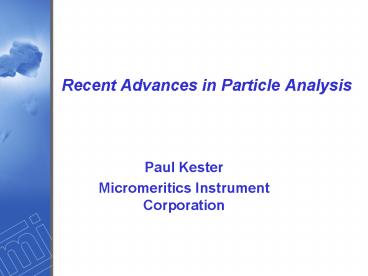Recent Advances in Particle Analysis PowerPoint PPT Presentation
1 / 32
Title: Recent Advances in Particle Analysis
1
Recent Advances in Particle Analysis
- Paul Kester
- Micromeritics Instrument Corporation
2
Areas of Interest for Ceramics
- Density
- Skeletal
- New uses of old technique
- Particle Size
- Comparison of Techniques
- New technique for nanoparticles
- Surface Area
- High Pressure Studies
3
Measure Skeletal Density at Various Stages
- Molded
- Debound
- Sintered
- Fully dense
- Check for theoretical Density
- Indicator for occluded pores
- Excessive sintering
- Indicator for removal of binder
4
Future ASTM Method for Density
- Committee B09 on Powdered Metals and Powdered
Metal Products - Sub-Committee B09.05 Structural Parts
- Work to start in 6-8 months
- Applies to parts after sintering
- Standard Method for Gas Pycnometry
5
Density Equilibration Rate
- Measure Rate of Equilibration for a material to
determine proper analysis parameters - Study Rate of Equilibration for various gases on
a material - May give information about tortuosity of pores
6
Particle Size Techniques
- Laser Light Scattering
- X-ray Sedimentation
- Electrical Sensing Zone
- Particle Size by Surface Area
7
Laser Light Scattering
- Widely used fast technique that can be applied to
various particulate systems - Easily automated in a variety of commercially
available instruments - Requires knowledge of Refractive Index of the
material - Data presented as Equivalent Spherical Diameter
8
Laser Light Scattering
- Historically laser scattering was performed at
small angles only, typically up to 14 , called - Fraunhofer diffraction
- Forward light scattering
- Low-angle laser light scattering (LALLS)
- Gave results down to 1 µm
- Now broadened to include wider angles with Mie
Theory optical modeling - Expanded range down to 0.1 µm
9
Types of Scattered Light
Laser Scattering
- Diffraction
- Reflection
- Refraction
- Absorption
10
Laser Light Scattering
- Groups of particles scatter light essentially
equal to the sum of light scattered by the
individual particles. - Optical models for selected particle sizes, and
mathematical deconvolution, allow computation of
the particle size distribution. - It is difficult to differentiate between single
particles and agglomerates or aggregates.
11
X-ray Sedimentation
- Based Upon a Classical Particle Sizing Method -
Stokes Law. - Same Sizing Principle as Andreasen Pipette and
Long-Arm Centrifuge. - Direct Mass Concentration Detection.
- X-Ray Attenuation is Proportional to Mass in
Beam. - Material Density must be Known
- Widely used in the Ceramic Industry
12
X-Ray Sedimentation
X-ray Sedimentation
- Stokes Law for Sedimentation, 1891.
- Mature, well understood and widely practiced
technique. - Now fully automated
13
Stokes equation
X-ray Sedimentation
- D particle diameter
- ? liquid viscosity
- v sedimentation velocity
- ? particle density
- ?o liquid density
- g acceleration due to gravity
14
X-ray Sedimentation
- Accounts for Particle Mass Outside Analysis
Range. - Analyzes Higher Concentrated Slurries than Most
Other Techniques. - Provides Reliable Analyses of Wide Size Range
300 µm to 0.1 µm. - Requires Only Readily-Available Physical
Constants as Parameters.
15
Particle Size Distribution Analysis of Fine
Calcium Carbonate Sample.
X-ray Sedimentation
16
Electrical Sensing Zone
- Same principle as Elzone 5380/5382 and Coulter
Multisizer 3 - Described by ISO 13319
- Particle suspended in a conductive liquid,
passing through a narrow orifice, increases
resistance through the orifice - Voltage must increase to keep constant current
through orifice, same as Elzone 5380 and
Multisizer 3 - Voltage change proportional to particle volume
17
Elzone II Principle of Operation
18
Elzone II Advantages
- Counts and sizes organic and inorganic particles
- Analyzes materials with mixed optical properties,
densities and shapes - Higher resolution than other sizing methods
- Lower quantity of sample needed for accurate,
easy analysis - Compact size takes up little lab space
- Automatic orifice blockage detection
19
Particle Size from Surface Area
- Increasing interest in nanomaterials
- Particle sizes lt 100 nm are of interest
- Most techniques in this range questionable
- Dynamic Light Scattering
- Provides Mean Size
- Difficult if bimodal
- Agglomerates make sizing difficult
- Obtain average size of primary particles from the
surface area and density of the material
20
Tantalum TEM Image
21
TiSi2 TEM Image
22
Nickel TEM Image
23
Carbon TEM Image
24
Particle Size from Surface Area
- 1 Volume (4/3)pr3)
- ----------------------
------------------- - BET x Density Area (4pr2)
- Reduces to
- 6
- D (nm) ---------------------- x 1000
- BET x Density
25
Comparison of Techniques
26
High Pressure Adsorption
- Increasing interest in measurement of adsorption
capacity of materials above atmospheric pressure - Adsorbent materials
- Gas purification
- Hydrogen Storage
- Catalysts
- Operate above atmospheric pressure
27
Static Adsorption
- Van der Waals forces
- Pressures to 150 psi
- Measure uptake of gases at various real life
pressures
28
High Pressure Isotherm
29
Dynamic Adsorption
- Chemical bonding
- Pressures to 1,000 psi
- Pulse Chemisorption
- Temperature Programmed
- Oxidation
- Reduction
- Desorption
- BET SA
30
High Pressure Chemisorption
31
Conclusions
- Our research is letting us use old techniques in
new ways to meet the needs of todays materials
and applications
32
Acknowledgments
- Jeff Kenvin - Micromeritics
- Greg Thiele - Micromeritics
- Tony Thornton - Micromeritics
- Rick Brown MVA Scientific Consultants

